The Art of Architectural Drawing
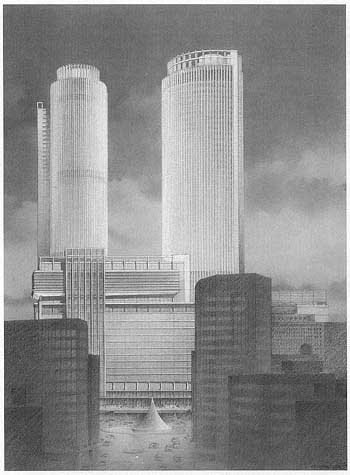
Nogoya Building, Japan, (1992) T.W. Schaller. Architects: Kohn Pedersen Fox. Pencil and pastel, 43cm 28cm Silhouetting the subject building as a light focal point against a dark surround serves the dual purpose of establishing clear visual identity and of allowing design specificity to be avoided in a developing scheme.
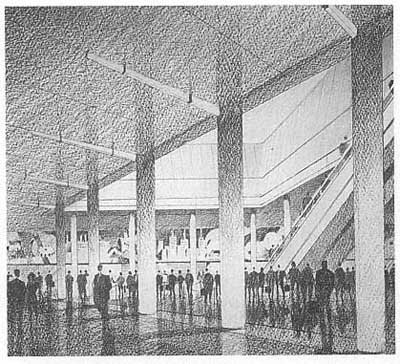
J.F.K International Airport Competition, New York, Baggage Level View. (1992) T.W. Schaller. Architects: Kohn Pedersen Fox. Watercolor and pencil, 42.9cm 66.3cm The attempt to allow natural light to penetrate the lower level in this proposal was also to become the essential idea of this resultant image.

J.F.K International Airport Competition, New York, Aerial Perspective View (1992) T.W. Schaller. Architects: Kohn Pedersen Fox. Watercolor and pencil, 78 117cm This image's composition and dramatic modeling of value range is an effort to underscore the signature design inspiration the shape of a wing.

I.M.C. Office Tower, Kuala Lumpur. (1992) T.W. Schaller. Architects: Tsao & McKown. Watercolor, 70.2cm 93.6cm A full night view was chosen here as an "evasive tactic" or an appropriate graphic response to a design scheme whose sculptural form was nearly set but whose surface materiality was far from being decided upon.

First Citizen's Bank and Trust Company Headquarters, Raleigh, North Carolina. (1990) T.W. Schaller. Architects: Kohn Pedersen Fox. Pencil, 78cm 117cm An informal and investigative sun angle and value sketch of this formal proposal inadvertently creates a compelling study in contrast.

Strivers Center, Harlem. New York City. (1992) T.W. Schaller. Client: NYC Economic Development Corporation. Watercolor, 70.2cm 96.3cm One of a series of "non-architectural" and atmospheric imagesthis view was completed in an attempt to gain community, political, and developmental interest in the potential renaissance of this inner city neighborhood.

(1995) Artist/Designer: Willem van den Hoed. Watercolor, 10.2cm 15.3cm The prolific Dutch-based architect/artist, Willem van den Hoed, incessantly explores architectural form and function in log books in which he quickly jots down thoughts and impressionsmuch like in a design-based visual diary. This piece is one of a series of possible combinations of a linear base form combined with other shapes.
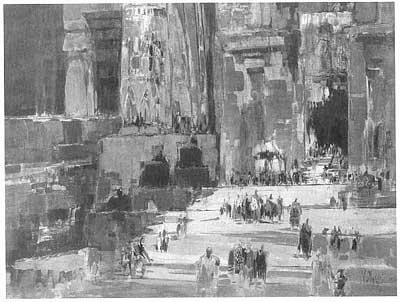
Interior of an Egyptian Temple. (1928) William Walcot (18741943). Pencil and gouache, 80cm 104cm; Courtesy of The British Architectural Library, RIBA, London. This piece is representative of Walcot's vigorous and eclectic approach to both his graphic endeavors and design interests as well. Bold, impressionistic mixed media "events" describe many of his images which, like this one, combined architectural fact and fiction to near-visionary result.

Waytufund Competition, Shanghai, China. (1996) T.W. Schaller. Architects: Fox & Fowle. Watercolor and pencil, each: 42.9cm 66.3cm A vital and active waterfront atmosphere was the impetus for this proposed design as well as the essential idea behind the compositional and media use choice for the images.
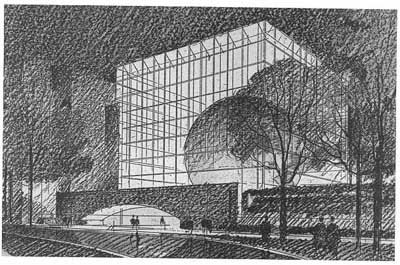
American Museum of Natural History, Hayden Planetarium, Night view from park, New York, (1995) T.W. Schaller. Architect: J. S. Polshek and Partners. Watercolor, 28cm 43cm The striking concept of a glowing orb in a transparent box was attempted here in the most direct and expositional manner.
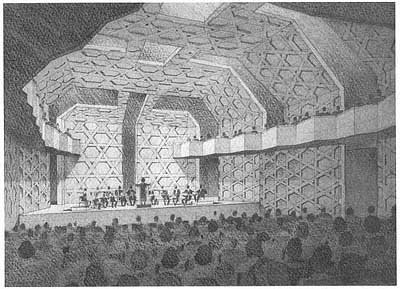
TCU Performance Center, Theater, Fort Worth, Texas. (1994) T.W. Schaller. Architects: Hardy Holzman Pfeiffer. Watercolor and pencil, 43cm 66.3cm This is one of a series of design development drawings done to explore the visual atmosphere created by this and several other of the unusual performance spaces planned for the facility.

